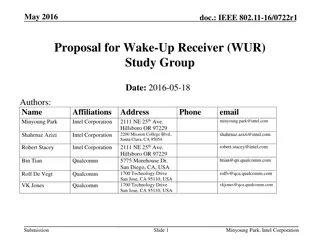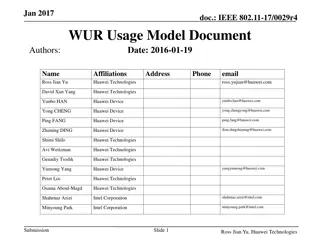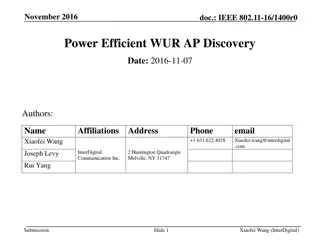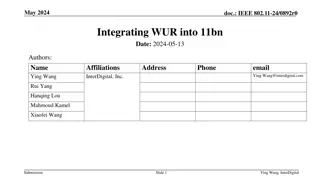Understanding IEEE 802.11-22/2083r1 Wake-Up Radio (WUR) and MC-OOK Signals
The document explores the IEEE 802.11-22/2083r1 specifications regarding Wake-Up Radio (WUR) PHY, focusing on WUR PPDU reception requirements and the use of multicarrier on-off keying (MC-OOK) signals. It examines the ambiguity surrounding MC-OOK in WUR PPDU compositions, emphasizing the need for cl
0 views • 27 slides
Proposal for Wake-Up Receiver (WUR) Study Group in IEEE 802.11-16
The document presents a proposal for the creation of a Wake-Up Receiver (WUR) Study Group within the IEEE 802.11-16 standard. The WUR technology aims to enable energy-efficient data reception without increasing latency, with a defined scope of work and feasibility. The proposal outlines the need for
0 views • 14 slides
IEEE 802.11-17/0029r4 WUR Usage Model Document
This document, dated January 2017, outlines usage models for wake-up radio WLAN standard. It includes details on various usage models like Smart Home, Warehouse, Outdoor Cattle Farms, Sensor Network Synchronized Wake Up, Wearable Devices, Moving Goods Tracking, and more. The document also explains t
0 views • 20 slides
Power-Efficient WUR AP Discovery in IEEE 802.11
Discussion on issues related to Access Point (AP) discovery using Wake-Up Radio (WUR) when the AP is in sleep mode, focusing on active scanning methods for quick AP discovery and association, including power-efficient wake-up frames and challenges with broadcast frames in IEEE 802.11 networks.
0 views • 9 slides
Integrating WUR into IEEE 802.11bn for Enhanced Network Efficiency
IEEE 802.11-24/0892r0 proposes integrating Wake-Up Radio (WUR) technology into 11bn networks to improve reliability, support low latency traffic, increase peak throughput, and enhance power-saving capabilities. The WUR acts as a companion radio to the main connectivity radio, enabling power-saving w
0 views • 10 slides




